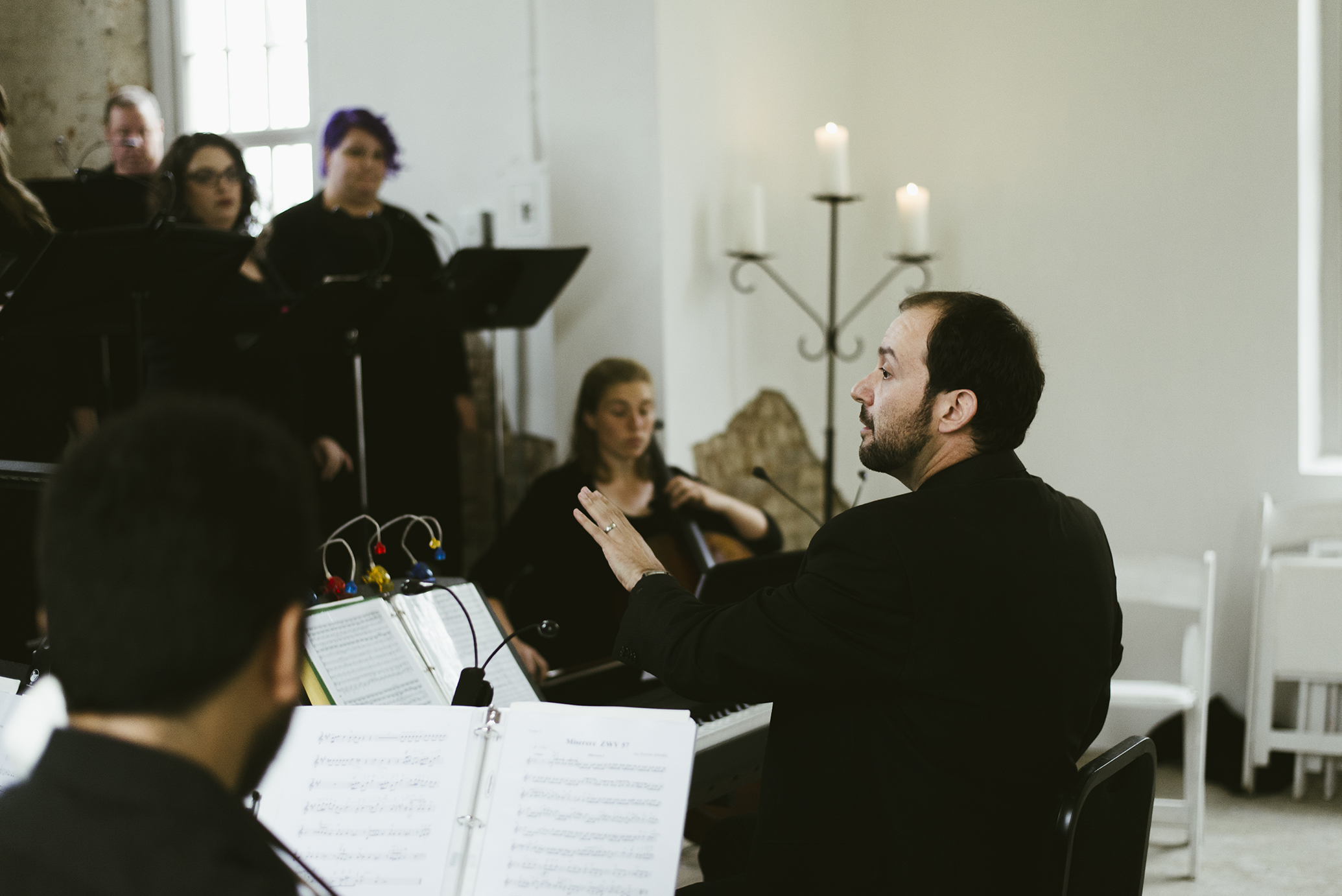
Baton Rouge Early Vocal Ensemble exposes audiences to a forgotten sound in an abandoned church and beyond
On Highway 66 north of St. Francisville, we came to a gravel road where two older gentlemen flagged us down. The gate of a pasture was swung open, and they motioned for us to drive through it, crossing the dewy green expanse to the far end by a line of trees and, also, a herd of cows.
An old abandoned church peeked out from behind the trees, its Gothic steeple pointing up above the canopy. And as the afternoon light dimmed on a foggy, drizzly Sunday evening, this church was where we’d spend the next few hours listening to an ensemble of professional vocalists perform Baroque music by nothing but candlelight.

If it sounds surreal, it was. From the aging brick church that looked like it should be in Northern Ireland instead of southern Louisiana, to the caravan of well-heeled St. Francisville and Baton Rouge figures who walked gingerly through the grass to the church, to the curious cows watching from the fenceline, it seemed like a secret ritual gathering.
|
|
In reality, the group known as the Baton Rouge Early Vocal Ensemble—accompanied by a six-piece orchestra—was performing as a fundraiser for the church. Built in 1857 and consecrated as St. Mary’s Episcopal Church, it fell into disrepair until it was more recently rescued by a non-profit group of historic preservationists.
“We had done some concerts in the St. Francisville area before,” says BREVE’s founder and artistic director William F. Plummer. “I had been aware of the church for some time … I thought it would be amazing to do something in a space like that.”
The non-profit, St. Mary’s Episcopal Church and Cemetery Association, had raised money to fix the church’s roof after a tree fell on it. They’d cleaned out the cobwebs and bird nests, replaced all the tall arched windows and even installed some rudimentary lighting.
To Plummer, the church aligned perfectly with BREVE’s mission to preserve and perform early music. “It’s really what we do musically all the time with the music of the past.”
Since 2010, BREVE has introduced audiences across the state to obscure religious music from the 16th and 17th centuries, mostly sung in Latin.
Plummer started the ensemble while he was a doctoral student in choral conducting at LSU.
“We were aware there really wasn’t anybody else in our state focusing on Renaissance or Baroque music,” he says. “So we’d get together and sing for fun in the stairwell of the School of Music building. It took us a whole year to get our first concert together, and gradually we’ve added other singers over the years.”
One of those singers is Madeline Magnon, a gifted soprano and professional musician from Lafayette who has been part of the ensemble for four years. At the St. Mary’s event that night, she performed several solos. While she is used to performing in church settings, she says this concert was special.

“A place like that, with just candlelight, it was so dim and you can’t rely on all your senses. As an audience member, you have to close your eyes and just experience the music,” she says.
Where the altar once stood, BREVE and the orchestra lined up on a makeshift riser and performed seven pieces for the sold-out crowd. As the light faded outside, candlelight and small LED lights on their sheet-music stands barely illuminated the room. Two windows at the back were kept open once the drizzly weather dissipated. Outside, a groundskeeper lit torches so patrons could later find their way back to their cars.
It all gave the impression we were still outside in the night air, with the natural acoustics letting us listen in on ethereal music from a choir almost hidden in darkness.
That was especially true during a doozy of a duet Magnon had with fellow soprano Hasmig Aroian. They performed François Couperin’s “Troisième Leçon de Ténèbres,” accompanied only by Plummer on the harpsichord.
Magnon and Aroian stood side by side and swayed slightly as their voices maneuvered around each other for the more than 13-minute piece.
“It was one of the scariest pieces I’ve taken on thus far,” Magnon says with a laugh. “Hasmig and I come from different backgrounds and different experiences … But you have to become one in that situation. I learned her musical tendencies in order to shape my sound, and she had to do the same.”
In the end, it earned one of the biggest applauses of the night, not only for their vocal marathon, but how intimate it felt.
“It was such a magical experience,” Magnon says. “After it was done, I remember leaning over and giving [Aroian] a hug.”

In a concert setting that is often reverent to the point of stuffiness, that also provided a sweet and genuine moment at the end.
Afterward, Plummer made us of all 11 ensemble members for the next piece, which provided the kind of chills you’d expect from witnessing a full choir performing as one.
Plummer says the compositions they select are meant for smaller groups, and the ensemble size is manageable enough to allow for what he calls a “clean and perfect sound. … You don’t feel the bite of one note against another note.”
It doesn’t come easily. The ensemble rehearses alone and as a group for months leading up to a performance.
“Ten to 12 rehearsals for a concert sounds like a lot, but it’s really not when you look at how intricate the pieces are,” Magnon says.
After the concert and standing ovation ended, most of the patrons lingered, still marveling over the space and the music they had just heard.
“You don’t often get to see things like that around here,” one man beamed.
As we drove home from the early March performance that night, BREVE’s members were likely already thinking about their next performances, with several on the roster around the state including an April 9 Lenten concert at
St. Mary Magdalene Catholic Church in Abbeville.
Though the venues change, Plummer says the ensemble’s “perfect sound” won’t.
“It’s going to feel more intimate than a large group,” he says. “It’s going to feel like a conversation.”
Find out more about the Baton Rouge Early Vocal Ensemble at earlymusicbreve.org. Find out about St. Mary’s Episcopal Church at stmarysla.com.
This article was originally published in the April 2017 issue of 225 Magazine.
|
|
|

